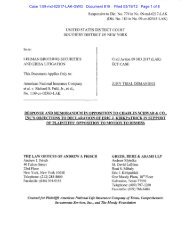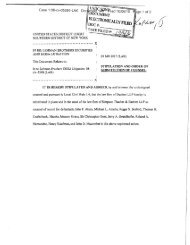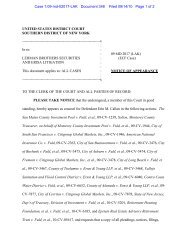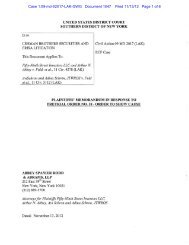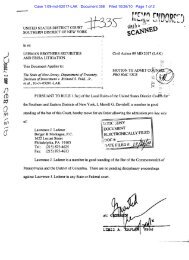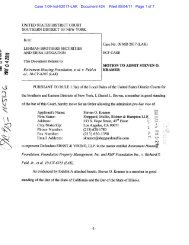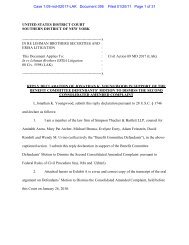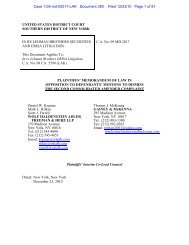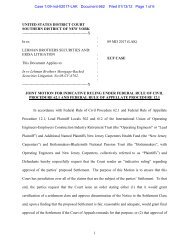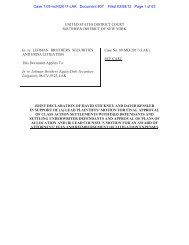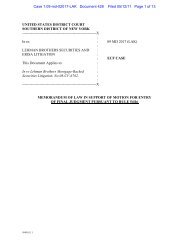Third Amended Complaint - Lehman Brothers Securities Litigation
Third Amended Complaint - Lehman Brothers Securities Litigation
Third Amended Complaint - Lehman Brothers Securities Litigation
You also want an ePaper? Increase the reach of your titles
YUMPU automatically turns print PDFs into web optimized ePapers that Google loves.
<strong>Lehman</strong>’s stress tests “meaningless,” and “<strong>Lehman</strong>’s management did not have a regular andsystematic means of analyzing the amount of catastrophic loss that the firm could suffer from thoseincreasingly large and illiquid investments.” In fact, experimental stress tests conducted in 2008indicated that a large proportion of <strong>Lehman</strong>’s risk lay with real estate and private equity positionsthat had not been included in the stress tests. For example, one stress test showed maximumpotential losses of $9.4 billion, which included $7.4 billion in losses on real estate and privateequity positions excluded from the stress tests. Another stress test showed potential total losses of$13.4 billion, of which $10.9 billion was attributable to the previously excluded real estate andprivate equity positions, and only $2.5 billion to previously included trading positions.81. <strong>Lehman</strong>’s Offering Materials, by incorporating the 2Q07 10-Q and 3Q07 10-Q, alsorepresented that “[w]e apply analytical procedures overlaid with sound practical judgment and workproactively with business areas before transactions occur to ensure appropriate risk mitigants are inplace.” Contrary to this statement, however, while <strong>Lehman</strong>’s mortgage-related risks hadsignificantly increased as it accumulated illiquid assets, <strong>Lehman</strong> failed to ensure that appropriaterisk mitigants were in place. These illiquid assets included residential Alt-A assets that <strong>Lehman</strong>could not directly hedge. In addition, <strong>Lehman</strong> did not increase the magnitude of its “macro hedges”– a technique used to eliminate the risks of a portfolio of assets – on its leveraged loan andcommercial real estate portfolios.82. The statement that <strong>Lehman</strong> “work[s] proactively with business areas beforetransactions occur to ensure appropriate risk mitigants are in place” was also false and misleadingbecause, unbeknownst to investors, by the start of the Class Period, <strong>Lehman</strong> had relaxed riskcontrols to accommodate growth of its commercial real estate business, including its bridge equitypositions in the United States, which increased more than ten-fold from $116 million in 2Q06 to$1.33 billion in 2Q07, and then more than doubled to exceed $3 billion by the end of 2Q08.<strong>Lehman</strong>’s real estate bridge equity deals were particularly risky because declining values of theunderlying real estate prevented <strong>Lehman</strong> from selling bridge equity positions as planned, such as-25-



